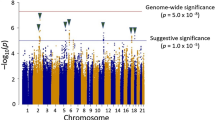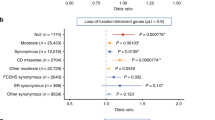Abstract
Acute encephalopathy with biphasic seizures and late reduced diffusion (AESD) is a severe syndrome of acute encephalopathy that affects infants and young children. AESD is a polygenic disorder preceded by common viral infections with high fever. We conducted an association study of human leukocyte antigen (HLA) regions with AESD using HLA imputation. SNP genotyping was performed on 254 Japanese patients with AESD and 799 healthy controls. We conducted 3-field HLA imputation for 14 HLA genes based on Japanese-specific references using data from our previous genome-wide association study. After quality control, 208 patients and 737 controls were included in the analysis of HLA alleles. We then compared the carrier frequencies of HLA alleles and haplotypes between the patients and controls. HLA-DPB1*04:01:01 showed a significant association with AESD, exerting a protective effect against the disease (p = 0.0053, pcorrected = 0.042, odds ratio = 0.43, 95% confidence interval = 0.21–0.80). The allele frequency of HLA-DPB1*04:01:01 was lower in East Asians than in Caucasians, which may partially account for the higher incidence of AESD in the Japanese population. The present results demonstrate the importance of fine-mapping of the HLA region to investigate disease susceptibilities and elucidate the pathogenesis of AESD.
This is a preview of subscription content, access via your institution
Access options
Subscribe to this journal
Receive 6 digital issues and online access to articles
$119.00 per year
only $19.83 per issue
Buy this article
- Purchase on Springer Link
- Instant access to full article PDF
Prices may be subject to local taxes which are calculated during checkout

Similar content being viewed by others
References
Mizuguchi M, Yamanouchi H, Ichiyama T, Shiomi M. Acute encephalopathy associated with influenza and other viral infections. Acta Neurol. 2007;115:45–56.
Takanashi J, Oba H, Barkovich AJ, Tada H, Tanabe Y, Yamanouchi H, et al. Diffusion MRI abnormalities after prolonged febrile seizures with encephalopathy. Neurology. 2006;66:1304–9.
Shinohara M, Saitoh M, Takanashi J, Yamanouchi H, Kubota M, Goto T, et al. Carnitine palmitoyl transferase II polymorphism is associated with multiple syndromes of acute encephalopathy with various infectious diseases. Brain Dev. 2011;33:512–7.
Shibata A, Kasai M, Hoshino A, Miyagawa T, Matsumoto H, Yamanaka G, et al. Thermolabile polymorphism of carnitine palmitoyltransferase 2: a genetic risk factor of overall acute encephalopathy. Brain Dev. 2019;41:862–9.
Shinohara M, Saitoh M, Nishizawa D, Ikeda K, Hirose S, Takanashi J, et al. ADORA2A polymorphism predisposes children to encephalopathy with febrile status epilepticus. Neurology. 2013;80:1571–6.
Saitoh M, Ishii A, Ihara Y, Hoshino A, Terashima H, Kubota M, et al. Missense mutations in sodium channel SCN1A and SCN2A predispose children to encephalopathy with severe febrile seizures. Epilepsy Res. 2015;117:1–6.
Shibata A, Kasai M, Terashima H, Hoshino A, Miyagawa T, Kikuchi K, et al. Case-control association study of rare nonsynonymous variants of SCN1A and KCNQ2 in acute encephalopathy with biphasic seizures and late reduced diffusion. J Neurol Sci. 2020;414:116808.
Kasai M, Omae Y, Kawai Y, Shibata A, Hoshino A, Mizuguchi M, et al. GWAS identifies candidate susceptibility loci and microRNA biomarkers for acute encephalopathy with biphasic seizures and late reduced diffusion. Sci Rep. 2022;12:1332.
Hoshino A, Saitoh M, Miyagawa T, Kubota M, Takanashi J, Miyamoto A, et al. Specific HLA genotypes confer susceptibility to acute necrotizing encephalopathy. Genes Immun. 2016;17:367–9.
Seo H-E, Hwang S-K, Choe BH, Cho M-H, Park S-P, Kwon S. Clinical spectrum and prognostic factors of acute necrotizing encephalopathy in children. J Korean Med Sci. 2010;25:449–53.
Hoshino A, Saitoh M, Oka A, Okumura A, Kubota M, Saito Y, et al. Epidemiology of acute encephalopathy in Japan, with emphasis on the association of viruses and syndromes. Brain Dev. 2012;34:337–43.
Kasai M, Shibata A, Hoshino A, Maegaki Y, Yamanouchi H, Takanashi J, et al. Epidemiological changes of acute encephalopathy in Japan based on national surveillance for 2014–2017. Brain Dev. 2020;42:508–14.
Kawahara Y, Morimoto A, Oh Y, Furukawa R, Wakabayashi K, Monden Y, et al. Serum and cerebrospinal fluid cytokines in children with acute encephalopathy. Brain Dev. 2020;42:185–91.
Ichiyama T, Suenaga N, Kajimoto M, Tohyama J, Isumi H, Kubota M, et al. Serum and CSF levels of cytokines in acute encephalopathy following prolonged febrile seizures. Brain Dev. 2008;30:47–52.
McCluskey J, Peh CA. The human leucocyte antigens and clinical medicine: an overview. Rev Immunogenet. 1999;1:3–20.
Tokunaga K. Lessons from genome-wide search for disease-related genes with special reference to HLA-disease associations. Genes. 2014;5:84–96.
Khor SS, Yang W, Kawashima M, Kamitsuji S, Zheng X, Nishida N, et al. High-accuracy imputation for HLA class I and II genes based on high-resolution SNP data of population-specific references. Pharmacogenomics J. 2015;15:530–7.
Nishida N, Ohashi J, Sugiyama M, Tsuchiura T, YamamotoK, Hino K, et al. Effects of HLA-DPB1 genotypes on chronic hepatitis B infection in Japanese individuals. Tissue Antigens. 2015;86:406–12.
Kamatani Y, Wattanapokayakit S, Ochi H, Kawaguchi T, Takahashi A, Hosono N, et al. A genome-wide association study identifies variants in the HLA-DP locus associated with chronic hepatitis B in Asians. Nat Genet. 2009;41:591–5.
König R, Huang LY, Germain R. MHC class II interaction with CD4 mediated by a region analogous to the MHC class I binding site for CD8. Nature. 1992;356:796–8.
Swain SL, McKinstry KK, Strutt TM. Expanding roles for CD4+ T cells in immunity to viruses. Nat Rev Immunol. 2012;12:136–48.
Kaech SM, Cui W. Transcriptional control of effector and memory CD8+T cell differentiation. Nat Rev Immunol. 2012;12:749–61.
Nabbout R, Vezzani A, Dulac O, Chiron C. Acute encephalopathy with inflammation-mediated status epilepticus. Lancet Neurol. 2011;10:99–108.
Hu S, Sheng WS, Ehrlich LC, Peterson PK, Chao CC. Cytokine effects on glutamate uptake by human astrocytes. Neuroimmunomodulation. 2000;7:153–9.
Takanashi J, Tada H, Terada H, Barkovich AJ. Excitotoxicity in acute encephalopathy with biphasic seizures and late reduced diffusion. AJNR Am J Neuroradiol. 2009;30:132–5.
Kawashima M, Ohashi J, Nishida N, Tokunaga K. Evolutionary analysis of classical HLA class I and II genes suggests that recent positive selection acted on DPB1*04:01 in Japanese population. PLoS One. 2012;7:e46806.
Mack S. A gene feature enumeration approach for describing HLA allele polymorphism. Hum Immunol. 2015;76:975–81.
Parham P, Ohta T. Population biology of antigen presentation by MHC class I molecules. Science. 1996;272:67–74.
Wang H, Cui Z, Pei Z, Fang S, Chen S, Zhu L, et al. Risk HLA class II alleles and amino acid residues in myeloperoxidase–ANCA-associated vasculitis. Kidney Int. 2019;96:1010–9.
Nakatani K, Ueta M, Khor S-S, Hitomi Y, Okudaira Y, Masuya A, et al. Identification of HLA-A*02:06:01 as the primary disease susceptibility HLA allele in cold medicine-related Stevens-Johnson syndrome with severe ocular complications by high-resolution NGS-based HLA typing. Sci Rep. 2019;9:16240.
Lind A, Akel O, Wallenius M, Ramelius A, Maziarz M, Zhao LP, et al. HLA high-resolution typing by next-generation sequencing in Pandemrix-induced narcolepsy. PLoS One. 2019;14:e0222882.
Kawai Y, Mimori T, Kojima K, Nariai N, Danjoh I, Saito R, et al. Japonica array: improved genotype imputation by designing a population-specific SNP array with 1070 Japanese individuals. J Hum Genet. 2015;60:581–7.
Anderson CA, Pettersson FH, Clarke GM, Cardon LR, Morris AP, Zondervan KT. Data quality control in genetic case-control association studies. Nat Protoc. 2010;5:1564–73.
Zheng X, Shen J, Cox C, Wakefield JC, Ehm MG, Nelson MR, et al. HIBAG-HLA genotype imputation with attribute bagging. Pharmacogenomics J. 2014;14:192–200.
Pappas DJ, Marin W, Hollenbach JA, Mack SJ. Bridging immunoGenomic data analysis workflow gaps (BIGDAWG): An integrated case-control analysis pipeline. Hum Immunol. 2016;77:283–7.
Long JC, Williams RC, Urbanek M. An E-M algorithm and testing strategy for multiple-locus haplotypes. Am J Hum Genet. 1995;56:799–810.
Purcell S, Neale B, Todd-Brown K, Thomas L, Ferreira MA, Bender D, et al. PLINK: a tool set for whole-genome association and population-based linkage analyses. Am J Hum Genet. 2007;81:559–75.
González-Galarza FF, Takeshita LY, Santos EJ, Kempson F, Maia MH, da Silva AL, et al. Allele frequency net 2015 update: new features for HLA epitopes, KIR and disease and HLA adverse drug reaction associations. Nucleic Acids Res. 2015;43:D784–8.
Acknowledgements
The authors are grateful to Ms. Aya Shoda for her technical assistance and to the Collaborative Research Supporting Committee of the Japanese Society of Child Neurology for promoting this study. We wish to thank all the pediatricians for providing patient samples, and the patients and their parents for participating in this study.
Funding
This research was supported by a Grant-in-Aid for Scientific Research, No. 15H04872, from the Japan Society for the Promotion of Science, and a Grant-in-Aid for Policy Research for Intractable Diseases, No. H30-Nanchi-Ippan-007, from the National Institute of Public Health, Japan.
Author information
Authors and Affiliations
Contributions
MK performed genotyping, conducted statistical analyses, and wrote the original draft; AH and MM collected samples; YO, KS-S, AS, AH, MM, and KT contributed to the materials and methods of the research and reviewed the manuscript; MM and KT conceived this study.
Corresponding author
Ethics declarations
Competing interests
The authors declare no competing interests.
Additional information
Publisher’s note Springer Nature remains neutral with regard to jurisdictional claims in published maps and institutional affiliations.
Rights and permissions
About this article
Cite this article
Kasai, M., Omae, Y., Khor, SS. et al. Protective association of HLA-DPB1*04:01:01 with acute encephalopathy with biphasic seizures and late reduced diffusion identified by HLA imputation. Genes Immun 23, 123–128 (2022). https://doi.org/10.1038/s41435-022-00170-y
Received:
Revised:
Accepted:
Published:
Issue Date:
DOI: https://doi.org/10.1038/s41435-022-00170-y



